You hear a lot about Drata, but you won't find Drata pricing on their site. It is more than just a subscription. Most teams learn the hard way that the real cost shows up only later through add-ons, renewals, and audits.
Founders often start with a clean quote. Then they hit limits, need extra frameworks, or discover that audits aren't included.
What looked like $15K quickly becomes $40K, and renewals climb even faster.
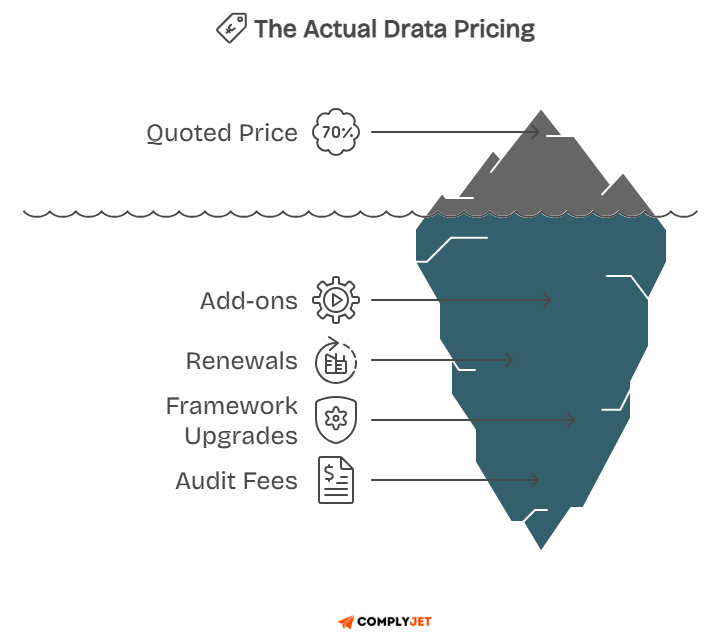
This guide breaks that cycle. We've pulled real 2025 Drata prices from AWS Marketplace, Reddit threads, Vendr reports, and G2 reviews.
You'll see what Drata plans really cost, how framework fees stack up, and why many teams are caught off guard in year two.
We'll also show:
- What each Drata plan includes and omits
- How SOC 2, ISO, HIPAA, and others impact price
- Common add-ons that raise your bill silently
- Price benchmarks for alternatives like Vanta, Secureframe, and ComplyJet
If you want a faster, founder-friendly compliance stack without mystery prices, see why startups switch to ComplyJet with just one click.
Now, let’s start with the basic Drata pricing plans.
Drata Pricing in 2025: What You'll Really Pay
Drata is a software tool that helps cloud-based companies manage security and compliance. It connects to your systems and checks whether you meet standards such as SOC 2, ISO 27001, HIPAA, PCI DSS, GDPR, and so on.
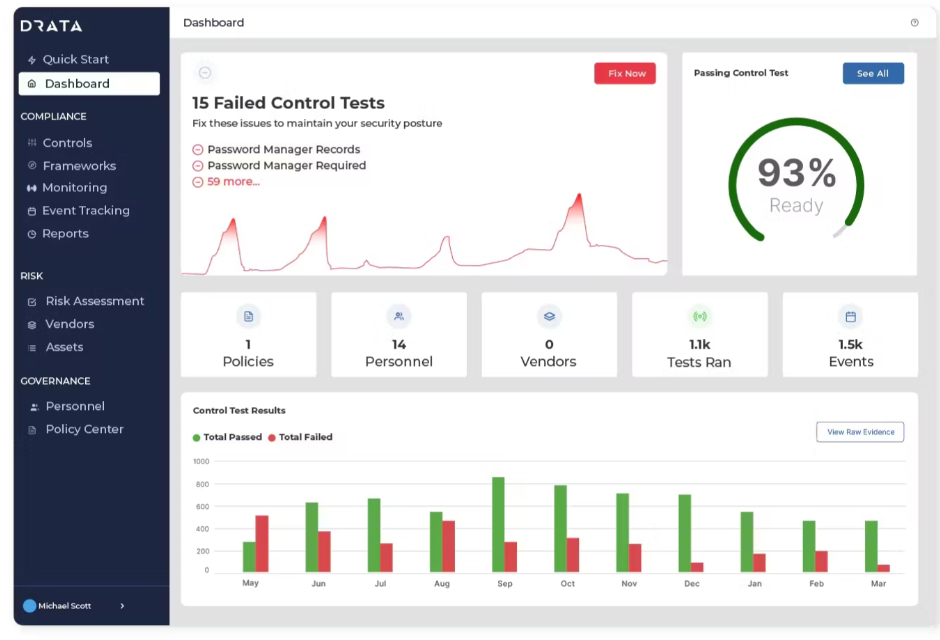
Instead of tracking everything in spreadsheets, Drata automates tasks like control checks, policy tracking, and evidence collection. This makes it easier to stay compliant as your business grows.
You probably searched for "Drata pricing" and landed on a form. That's not by accident. Drata doesn't publish its prices because most deals are custom. But the real costs follow a pattern.
Drata uses a tiered model with a starting price of $7500/year, according to the AWS Marketplace, extending up to $40,000/year with framework add-ons, platform limits, and surprise renewals. And most of this shows up after you've signed the contract.
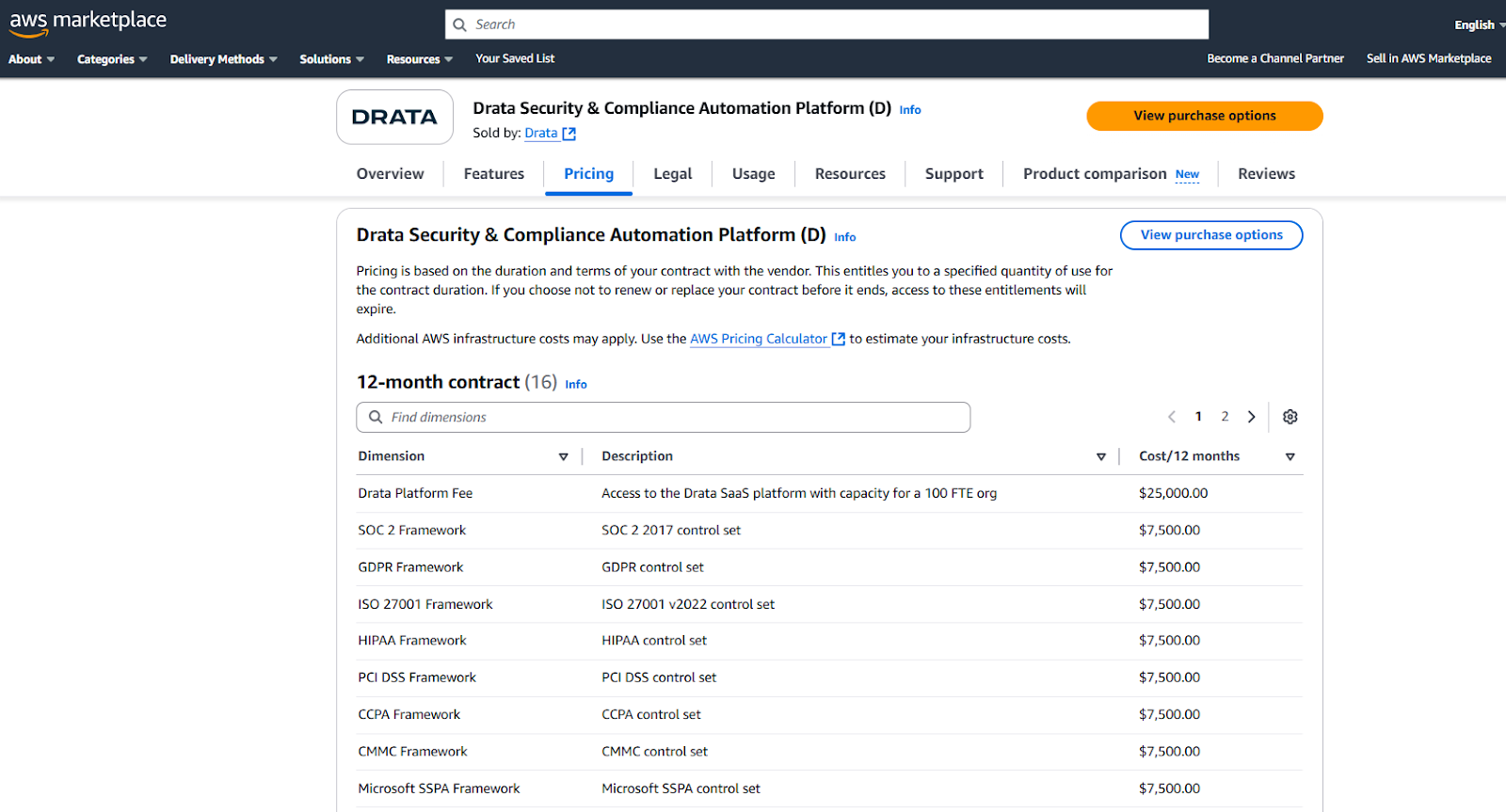
Most early-stage teams start with the Drata Foundation Plan, priced around $7,500 per year. It covers one framework, basic features, and up to 50 employees.
The next step up is the Drata Advanced Plan, usually $15,000 to $25,000 annually. This gives you more users, custom controls, and API access. It's the most common choice for growing startups.
Larger companies use the Drata Enterprise Plan, which ranges from $50,000 to $100,000+. This adds premium automation, advanced risk modules, and dedicated support.
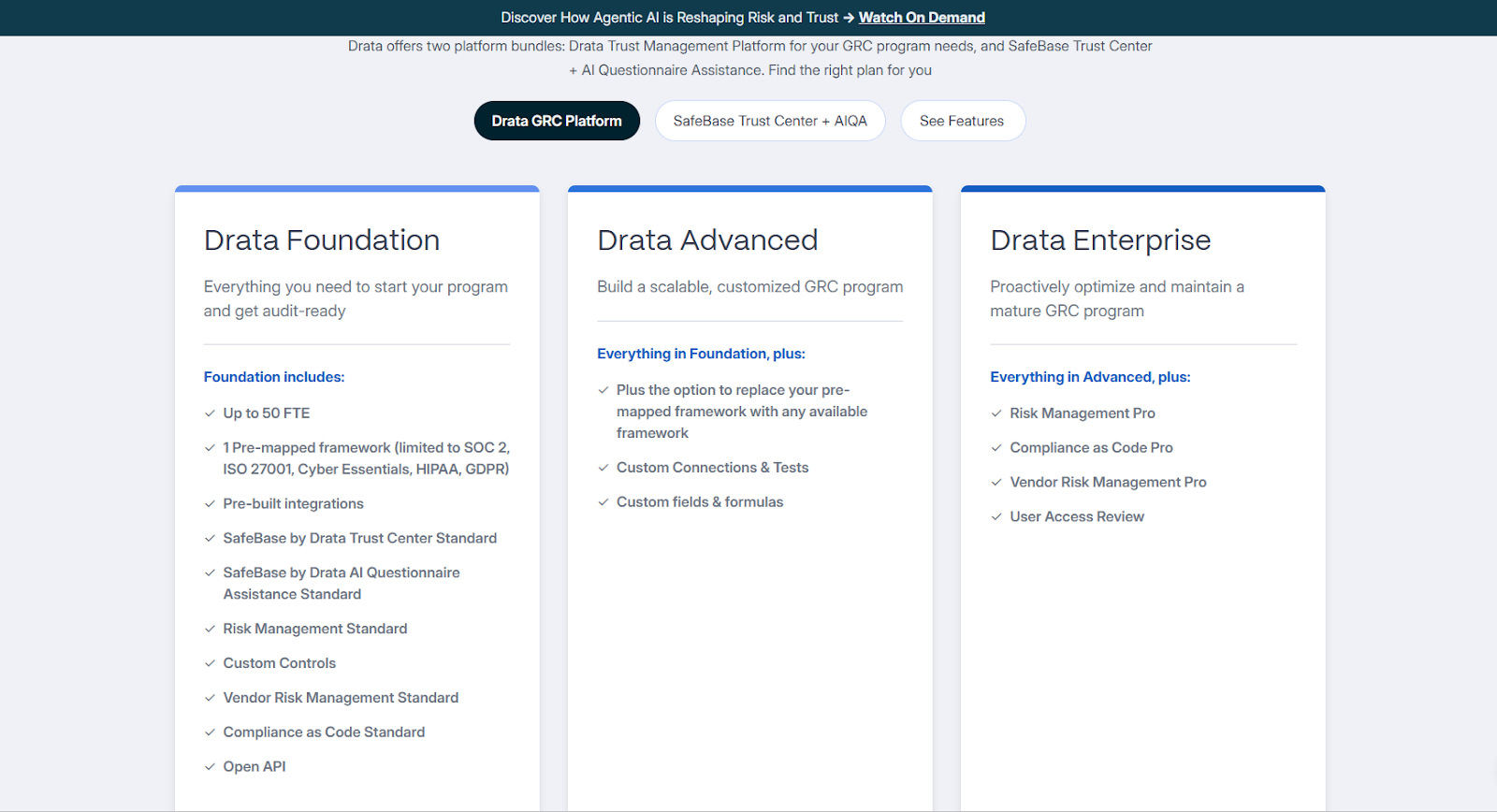
Tier 1: Drata Foundation Plan (~$7,500/year)
You start here when you have lean compliance needs and a small team. It's the entry‑level tier for the Drata pricing model and works when you only need one framework and basic automation.
Companies with under 50 employees often land here. According to AWS Marketplace, the Drata Foundation level begins around $7,500–$10,000 per year.
This plan grants a pre‑mapped framework (SOC 2, ISO 27001, HIPAA, etc.), core compliance automation and integrations, and basic vendor risk management.
Learn more: Core Features of Drata and how it works with real workflows
What you won't get: Advanced features like open APIs, complex workflows, or multi‑entity workspaces. The value is solid for startups, but expect limitations if you grow fast.

Tier 2: Drata Advanced Plan (~$15,000‑$25,000/year)
When you're scaling and need deeper compliance support, you shift into Drata's Advanced tier.
User reports, according to Spendflo, suggest most companies end up between $15K and $25K annually in this tier.
This plan adds more flexibility: unlimited user coverage (instead of a fixed head‑count cap), open API access, user‑access review features, and more robust vendor risk workflows.
You get a smarter compliance stack. It's targeted at companies with 50‑200 employees, supporting one or two frameworks, and wanting better automation.
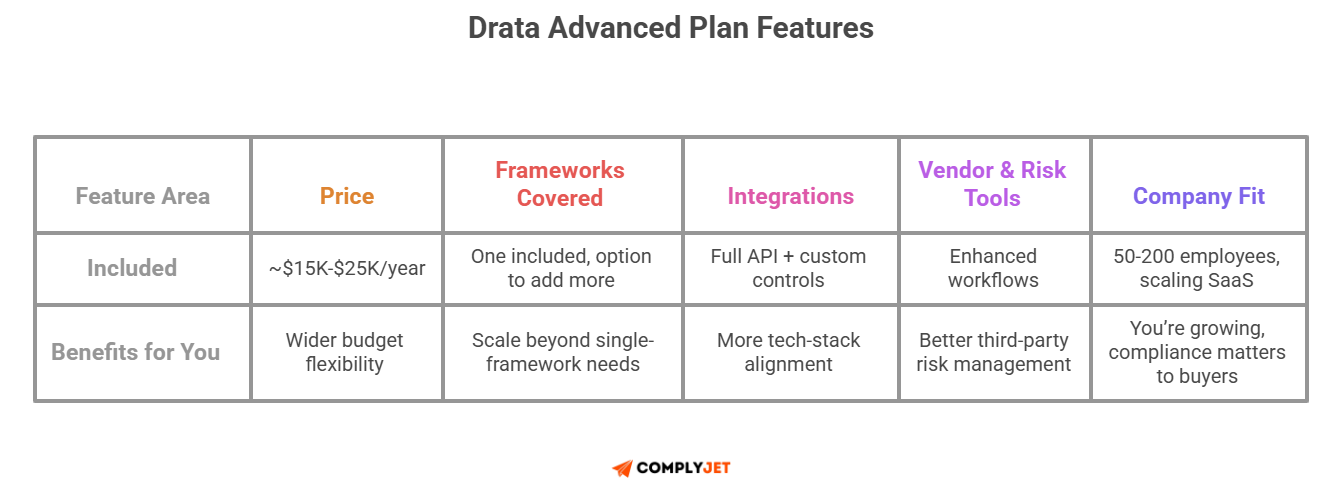
Tier 3: Drata Enterprise Plan (~$80K+ /year)
If your compliance landscape is complex with multiple frameworks, global subsidiaries, and custom control sets, you're looking at Drata's highest tier.
Custom quotes typically run $ 50,000–$100,000+ per year, depending on how many frameworks, workspaces, custom modules, and integrations you need.
In this tier, you get everything: multiple frameworks out of the box, Audit Hub Pro, vendor risk management pro features, custom workflows, dedicated customer success, multi‑entity workspaces, and the highest level of automation. You're enterprise‑grade.
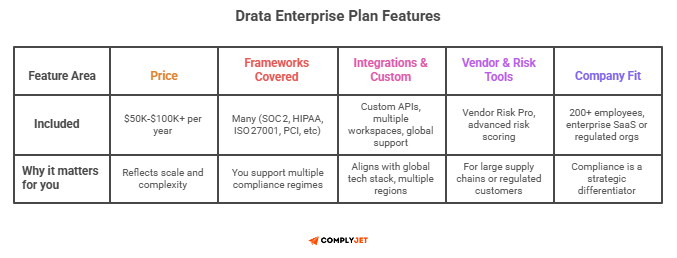
Real-World Pricing
According to Vendr, the average Drata contract is $34,385/year. Spendflo reports deals going as high as $42,750. On Reddit, some teams paid $10K, while others hit $45K for the same plan size.
These differences often come down to negotiation and the scope of use. Some teams pay extra for frameworks they don't use yet, or run into renewal jumps after year one.
How to Choose Your Tier
As a founder, decide first what you're solving:
- If you need one framework to win early enterprise deals, Drata Foundation may suffice.
- If you anticipate scaling users, vendors, or frameworks, Drata Advanced is safer.
- If you're managing global compliance, complex audits, or many vendors, skip ahead to Drata Enterprise.
Learn more: When should you choose Drata?

Tier Fit Summary:
Who Buys What?
- Drata Foundation: 10–20 person startup with only SOC 2 needs
- Drata Advanced: SaaS teams in growth mode, needing more control and coverage
- Drata Enterprise: Enterprises juggling SOC 2, HIPAA, ISO 27001, and complex reviews
The catch? If you scale, you'll get nudged up a tier quickly.
In the next section, we'll unpack how frameworks themselves increase cost with the "silent multiplier" behind Drata pricing.
Framework Fees: The Silent Multiplier
Drata's platform fee is just the start. The bigger line item is frameworks. Most teams need more than one, and that's where costs stack fast.
Drata includes one framework by default. Every additional one, like HIPAA or ISO 27001, costs around $1,500 per year. For some enterprise setups, it can jump to $7,500 per framework.
These are the most common compliance frameworks:
- SOC 2 (Type 1 or 2): Checks if a company keeps customer data safe and systems secure.
- ISO 27001: A global rulebook for managing and protecting company information.
- HIPAA: U.S. law that keeps people’s health data private and secure.
- GDPR: EU law that gives people control over how their personal data is used
- PCI DSS: Makes sure companies handle credit card information safely.
- CCPA: California law that lets people see, delete, or stop sharing their personal data.
- NIST CSF: A guide for companies to improve their cybersecurity and reduce risks.
- Cyber Essentials: A UK certification that helps protect businesses from common online attacks.
Each is billed separately. Want SOC 2 and ISO? That's two charges.
Real Examples From Buyers
Here's what it looks like in practice. A team on the Drata Advanced plan at $15,000 adds HIPAA and ISO 27001. That's another $3,000 per year minimum. Your new base is $18,000.
At renewal, they add GDPR and PCI DSS. Now they're at $24,000+, and that's before factoring in audit costs or implementation help.
One Reddit user shared they started at $7,500 and were quoted over $20,000 in year two just from adding frameworks. That's how fast this adds up.
It's common to start with one and add more. But each add-on brings more audit scope, more automation, and more dollars.
Here’s another verified Drata user affirming that the pricing is not startup-friendly:
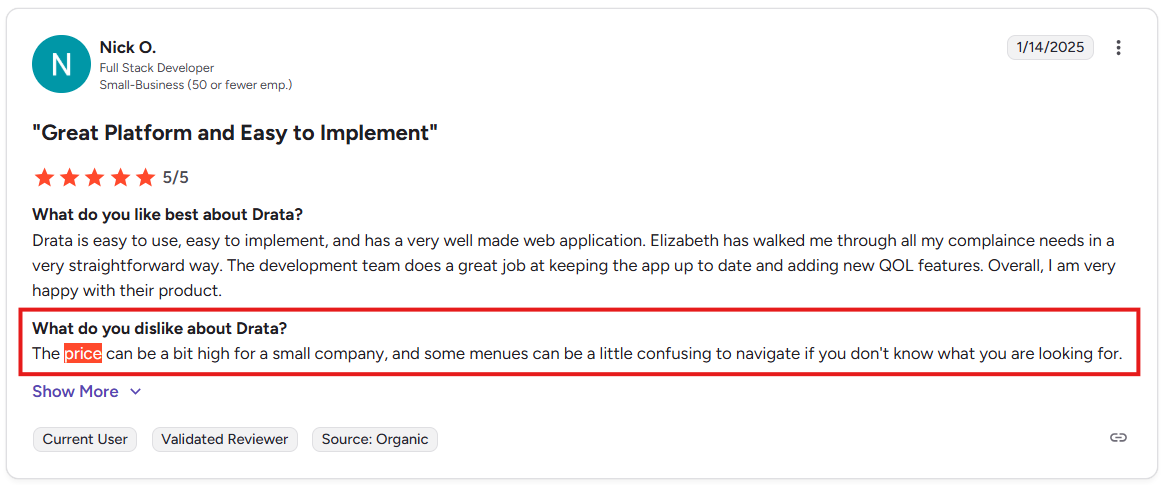
Read: Drata Reddit User Reviews
A Quiet Way to Save
Bundling frameworks during the first contract can lower the total. Drata reps often give discounts when you add two or more upfront. Waiting usually triggers a full price later.
Framework costs aren't obvious until renewal time. If you plan to grow, price that in now before it's too late.
Next, we'll look at what Drata doesn't tell you about hidden fees, onboarding, and renewals.
Hidden Fees You Won't See in the Demo Call
By the time you get Drata's proposal, most big costs are still hidden. The sales call sticks to platform fees. But what drives up your spend are the quiet extras that show up later.
We've heard from teams who started with a $15K plan and ended up crossing $40K. These are smart founders. What got them was a lack of visibility into what gets added after onboarding.
Implementation and Setup Fees
Some Drata customers are quoted up to $25,000 for implementation. This includes policy mapping, integrations, onboarding help, and compliance workshops.
You won't see this on the pricing page. And many buyers assume setup is included. It's not. These fees vary by team size and frameworks, but they hit fast.
Larger teams or complex environments (AWS, Okta, Snowflake) often require dedicated onboarding or a partner-led implementation.
Premium Features, Premium Pricing
Features such as Trust Centre Pro, User Access Reviews, and Multi-Entity Workspaces are not included in the base plan. These are often reserved for Foundation or Enterprise tiers or offered à la carte.
Each of these adds to your bill. Some features are compliance-critical, like user access reviews for ISO and HIPAA. So you end up paying extra whether you planned to or not.
Reddit threads and G2 reviews often flag this surprise, especially during renewal time.
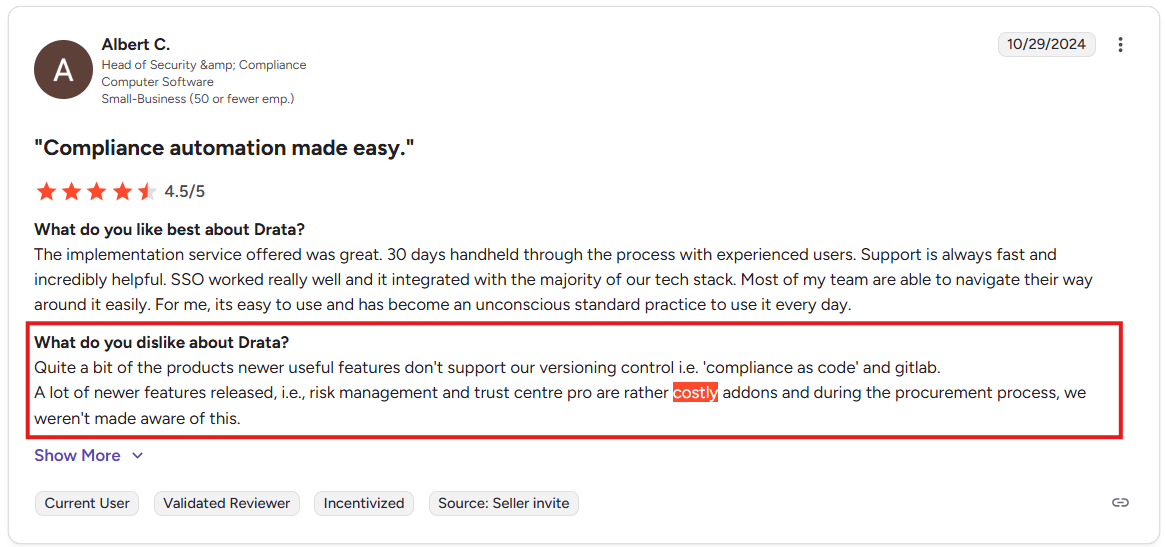
Read: Verified Drata User Reviews
Custom Integrations
Need an integration that Drata doesn't support natively? Prepare to pay $5,000 to $10,000 per custom integration. This includes scoping, implementation, and ongoing support.
Common asks include databases, internal tools, or non-standard cloud infrastructure. If you're scaling or migrating often, these costs repeat.
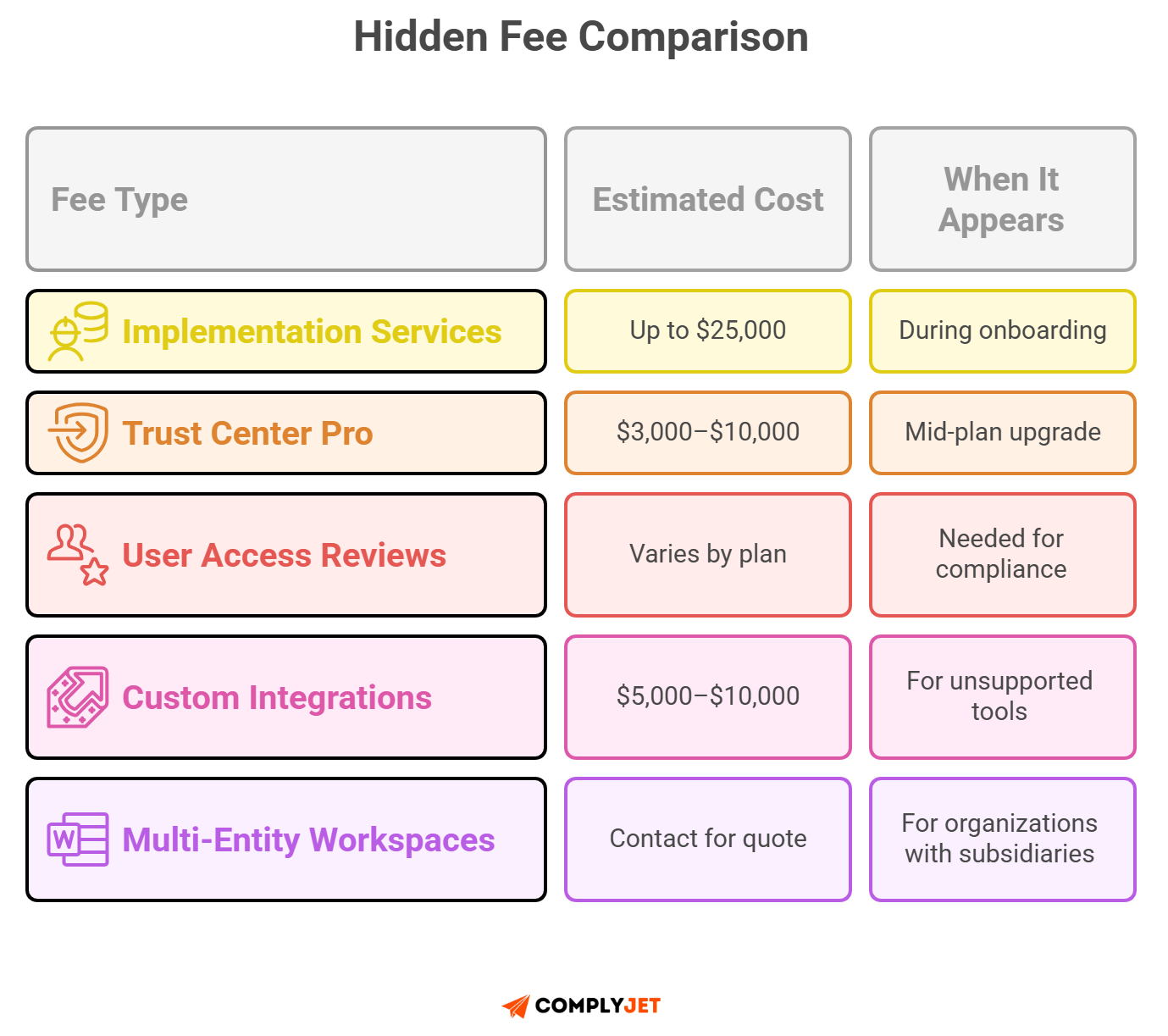
These add-ons are easy to miss during early sales calls. But they show up at renewal, which often comes with a pricing surprise of its own.
Audit Fees Are Separate and They Add Up
Many teams assume their compliance automation tool includes the audit. Drata doesn't. You'll still need a certified public accountant (CPA) firm to do the actual attestation.
This is where most teams feel the second wave of cost. Even if you nailed your prep, audits come with their own timelines and price bands.
SOC 2 and ISO 27001 Costs
For a SOC 2 Type 1 audit, expect to pay $5,000 to $15,000, depending on your team size and auditor.
A SOC 2 Type 2 audit ranges from $15,000 to $50,000. More controls, more testing, longer time frames.
ISO 27001 certification audits are similar. A typical ISO audit lands between $10,000 and $30,000, often across two stages: readiness and certification.
Drata's platform helps you prepare, but the CPA firm runs the audit. You coordinate both timelines.
Platform + Audit = True Cost
This separation catches founders off guard. You finish your Drata onboarding, only to realise you haven't booked an audit yet. Now you’re juggling vendors and deadlines.
Audit coordination takes time. Some buyers get stuck choosing firms. Others delay and end up paying rush fees to stay on schedule.
If you're budgeting for compliance, don't stop at the platform fee. Add the full audit costs to get a real view of your total spend. Up next: how Drata's pricing compares to Vanta, ComplyJet, and others.
Real-World TCO: What Companies Actually Pay
On the surface, Drata's cost feels reasonable. But your actual total cost of ownership (TCO) depends on your frameworks, team size, and how fast you're scaling.
The gap between sticker price and actual spend gets wider as your compliance program grows. Over a year or two, what started as a $15K tool can snowball into a $100K+ line item.
Startup: Single Framework
If you're a seed-stage startup targeting just SOC 2, you'll likely start with the Drata Foundation or the Drata Advanced plan. That's $7.5K to $15K per year for the platform.
Now add SOC 2 fees (~$1.5K), audit costs (~$10K), and setup support if needed (~$5K). Year 1 TCO lands around $25K to $30K. Year 2 goes up if the renewal increases kick in.
This stage is where many teams realise the base plan doesn't cover everything they need, especially if they're aiming to move fast.
SaaS Scaleup: Dual Framework
If you're Series A+ and targeting SOC 2 + ISO 27001, your plan usually jumps to Drata Advanced or Drata Enterprise. That's a $25K–$50K platform spend annually.
Each framework adds $1.5K to $7.5K, depending on what's bundled. Then audits stack up—often $30K to $40K total for both. Add another $10K for custom features.
Your TCO for year 1? Around $60K–$80K. Renewal in year 2 often comes with 20%–40% increases if you didn't lock rates early.
Enterprise: Multi-Framework + Custom
At the enterprise level, Drata plans are fully customizable. This group uses Trust Centre Pro, multiple subsidiaries, and SSO integrations. Pricing starts near $75K/year just for the platform.
With 3–5 frameworks, custom integrations, and internal control workflows, TCO often hits $150K–$250K+ by year 2. Implementation alone can cost $25K+.
Many vendors include a compliance manager or managed service model here, which adds even more if not negotiated upfront.

Knowing your TCO helps you set better budget expectations early. Next: what do you actually get in return for that spend?
ROI Analysis: Does Drata Actually Save Time & Money?
Drata promises automation, but does it really reduce compliance costs? The answer depends on how your team uses the tool and how you value time.
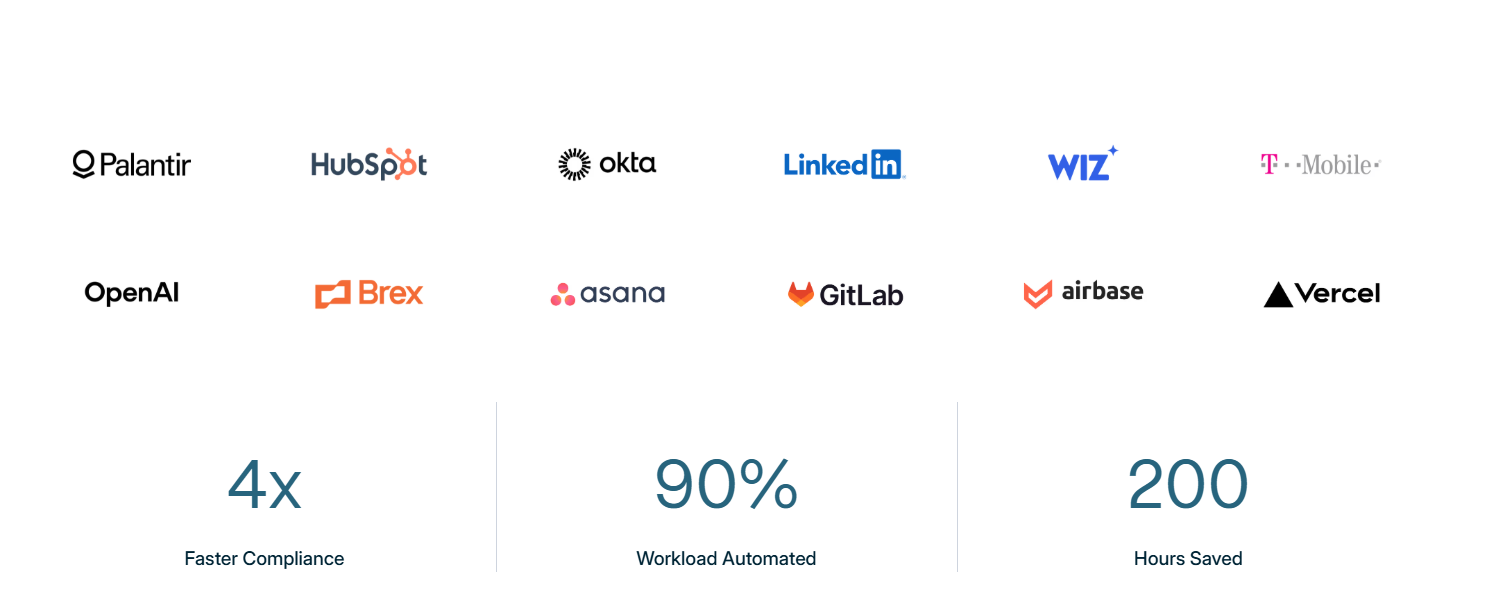
We've seen early-stage teams cut prep time by 85%. But ROI shows up differently when you compare headcount savings and sales speed.
Time and Headcount Savings
For many startups, the biggest gain is time. Drata reduces manual work around evidence collection, control tracking, and audits. This saves up to 150–200 hours per year.
Hiring a full-time compliance manager costs $80K to $150K/year. With Drata, many teams get by without adding that headcount until Series B or later.
You still need someone to drive the program. But the tool reduces grunt work significantly, especially when paired with templates and automations.
Faster Sales Cycles
Most buyers need SOC 2 to close deals with enterprise clients. With Drata, some teams go from zero to audit-ready in 6 to 8 weeks, which means faster contract cycles.
One CTO told us that having a Trust Centre shaved 3–4 weeks off every deal. That matters when you're fighting for logos before your next raise.
Drata's real value shows up when the compliance checkbox turns into closed revenue.
ROI Model Example
Let's take a $15K Drata plan, plus $10K for audits. If you avoid a $120K compliance hire and unlock $200K in deals faster, your break-even hits within 6–9 months.
Beyond year one, ROI grows as you reuse controls, automate tasks, and avoid penalties or blocked sales.
The ROI is real, but only if you deploy Drata with intent.
If you want a pricing benchmark without a long sales call, talk to ComplyJet's founders for a pricing comparison in 15 minutes.
With the ROI factors explained, let’s see how you can further negotiate and lower your custom Drata quote.
Negotiating Drata Pricing: What Actually Works
Drata pricing isn't fixed. Founders who negotiate smartly often save 20–30% or get premium features added at no charge. But timing and leverage matter more than anything.
Your quote depends on seat count, frameworks, and contract length. The good news: Drata sales teams respond well to data-backed negotiation.
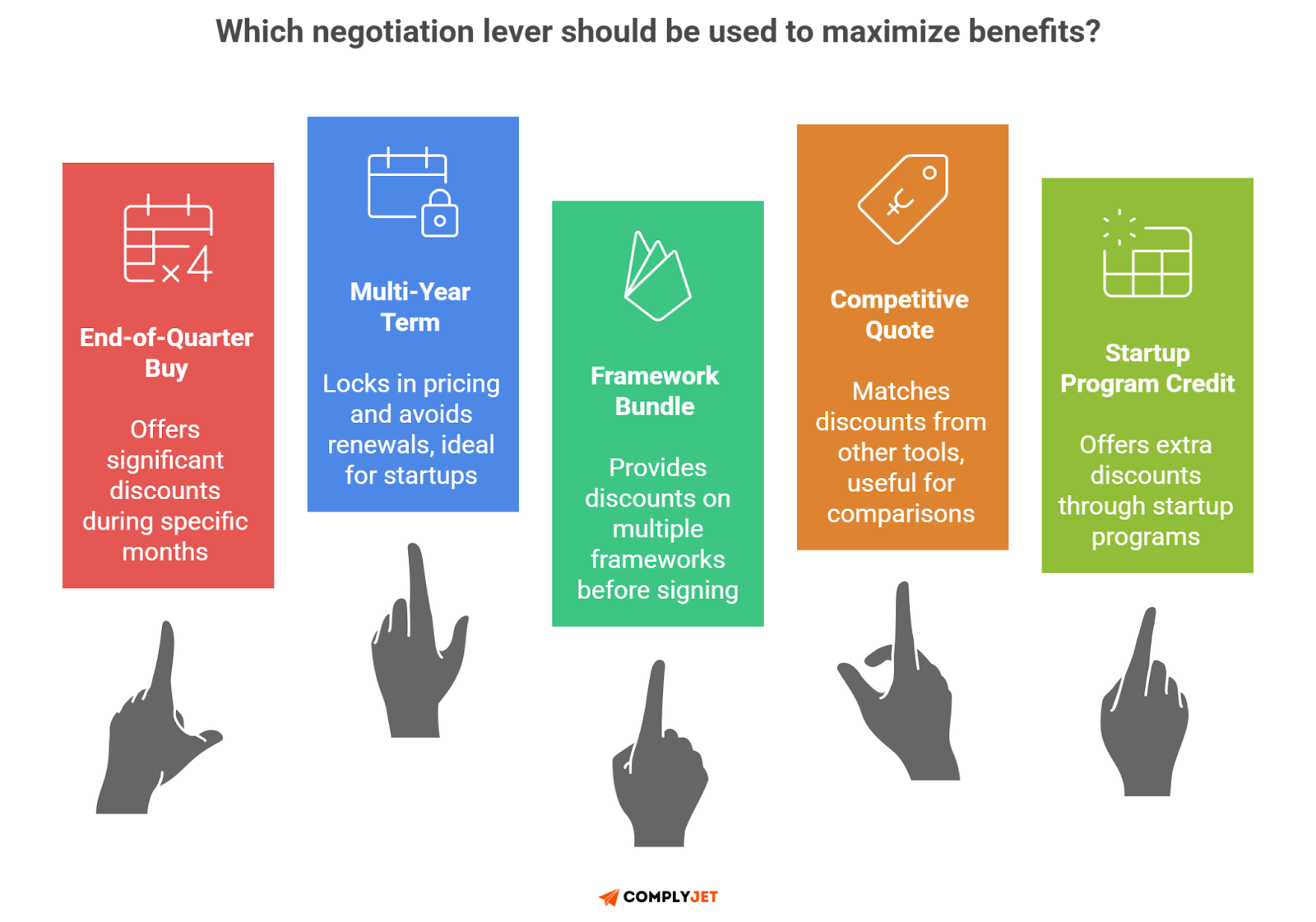
Time Your Ask
End of quarter is gold. That's when sales teams scramble to close. Deals move faster, and discounts go deeper if you're ready to sign.
Multi-year commitments also help. Signing for 2–3 years often brings 10–20% off if you press on it. Just watch for baked-in renewal hikes.
Ask for onboarding fee waivers early. Some teams pay $5K–$10K for setup, but reps can flex if you push.
Bring Comparison Quotes
Mention Vanta or Secureframe quotes during the negotiation. Sales teams are used to this, and it puts pressure on margins. Real quotes beat vague references.
Bundling frameworks like SOC 2 + ISO upfront also helps. Drata may quote $1.5K–$7.5K per framework, but you can get a lower blended rate.
Finally, bring up startup programs. If you're in AWS Activate, YC, or similar, ask for those discounts. Drata honours most of them if you ask.
Quick Drata Price Negotiation Tips:
Negotiating isn't awkward when you approach it with data.
Next up, we'll tell you when paying Drata's price makes sense and when you're better off with something leaner.
When Drata Makes Sense and When It Doesn't
Drata is powerful, but it's not for every team. It shines when automation depth and scale matter more than simplicity or budget control.
If you have internal compliance knowledge and want to manage frameworks across a large org, it's worth the spend. But early teams often overpay for features they don’t use yet.
Go with Drata if…
- You have 50–500 employees
- You need multiple frameworks
- You have a strong technical team
- You want deep automation and integrations
Read: Drata Pros and Cons
Drata's compliance automation and integrations across AWS, Okta, and GCP are its real strengths. Larger security teams can get full control and visibility in one dashboard.
Consider alternatives if…
- You're under 20 people
- You need only SOC 2
- You dislike sales-driven pricing calls
- You want faster, cheaper onboarding
ComplyJet is better here with transparent pricing and human guidance. Startups get audit-ready in 7–15 days without complex setup or tiered fees.
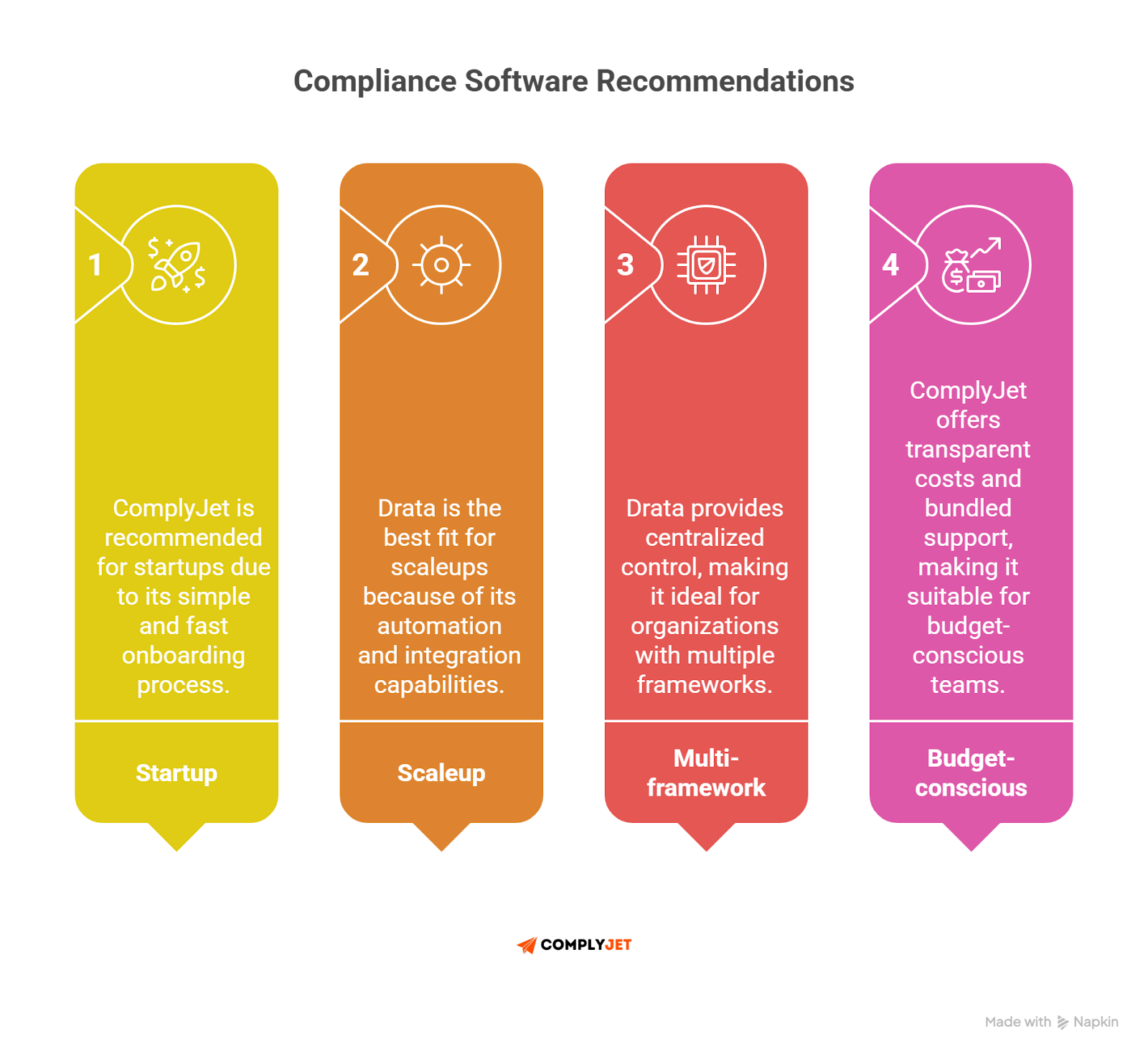
If you're scaling compliance maturity, Drata can grow with you. But if you’re starting from scratch, ComplyJet’s prices might save you thousands in fees and months of set-up.
Looking for more alternatives? Read: Drata Competitors and Alternatives
FAQs on Drata Pricing and Features
How much does Drata cost per year?
Drata pricing in 2025 starts around $7,500 per year for smaller teams. Most SaaS companies with multiple frameworks spend $15,000 to $25,000.
Larger organisations often cross $50,000–$100,000+ annually once audits, add-ons, and renewals are included.
Real-world data from platforms like Vendr and Reddit show that the total cost of ownership (TCO) increases sharply in year two, mainly due to framework expansions and premium feature upgrades.
Does Drata charge for audits?
Yes. Drata’s pricing covers audit readiness, not the audit itself. You’ll need to hire a third-party CPA firm to perform SOC 2, ISO 27001, or HIPAA audits.
Costs for these audits typically range from $5,000 to $50,000, depending on scope, size, and whether it’s a Type I or Type II audit.
Drata’s role is to streamline evidence collection and communication between your team and the auditor, not to issue the certification.
Is Drata better than Vanta for SOC 2?
For SOC 2 compliance, Drata and Vanta both automate control monitoring, but they target different users. Drata focuses on deeper technical automation with a strong developer experience. Vanta is easier for smaller teams that want simple onboarding and clearer pricing.
If your company handles complex infrastructure and multiple frameworks, Drata offers more flexibility. For early-stage teams, Vanta’s guided workflows can feel simpler to manage.
Learn more: Vanta Review 2025: Data Breach, Billing traps, and when it’s worth it?
Why is Drata so expensive compared to competitors?
Drata’s pricing reflects its automation depth, integrations, and enterprise-grade compliance coverage. It’s designed for teams that need continuous monitoring, role-based access reviews, and advanced risk management features.
Read: Drata VS Competitors
The higher cost also comes from implementation fees, premium support, and Trust Centre Pro features, which are often billed separately. Users on G2 and TrustRadius often cite strong functionality but note that costs scale quickly as frameworks increase.
What’s included in the Drata Advanced plan?
The Drata Advanced plan is Drata’s mid-tier subscription, typically priced between $15,000 and $25,000 per year. It includes:
- Automation for evidence collection and testing
- Multiple framework management (SOC 2, ISO 27001, HIPAA)
- Integrations with major cloud and HR tools
- Basic Trust Centre access
- User access reviews and reporting
This plan suits growth-stage companies managing more than one framework or needing centralised visibility across departments.
How can I reduce my Drata bill in 2025?
Reducing Drata’s cost often comes down to timing and negotiation. Founders who:
- Sign near quarter-end often get the best discounts
- Commit to multi-year contracts can save 10–20%
- Bundle frameworks upfront reduce per-framework fees
- Ask for onboarding or Trust Center Pro waivers avoid hidden charges
Using startup credits (like AWS Activate or YC benefits) also helps offset early costs.
Can Drata handle HIPAA, ISO, and SOC 2 together?
Yes. Drata supports multi-framework compliance across SOC 2, ISO 27001, HIPAA, GDPR, and PCI DSS. Each framework can be mapped together to reduce overlap in controls.
Pricing increases with each added framework, usually between $1,000 and $7,500 per year. This makes it easier to maintain compliance across multiple standards within one dashboard.
What’s the difference between Drata and Vanta?
Drata emphasises deep automation, engineering-driven workflows, and continuous monitoring. Vanta focuses on guided onboarding, simpler pricing, and a strong customer experience for smaller teams.
In short:
- Drata = better for scaling tech companies with a security team
- Vanta = better for startups that want speed and simplicity
Read: Vanta VS Drata: Which Compliance Tool is Right for You in 2025?
Is Drata pricing negotiable?
Yes, Drata pricing is negotiable. Buyers have reported discounts of 15–30% through:
- Quarter-end signings
- Multi-year contracts
- Bundling frameworks like SOC 2 and ISO together
- Providing comparison quotes from other compliance platforms
Drata’s sales model allows flexibility, but you’ll need to request specific discounts directly during the deal stage.
Do I need a third-party auditor with Drata?
Yes. While Drata automates audit readiness, it does not issue the audit report. You’ll still need a licensed third-party CPA or audit firm to complete SOC 2 or ISO 27001 certification.
Drata integrates with several audit partners and provides tools to share evidence securely, but the audit remains a separate engagement and cost.
How many integrations does Drata support?
As of 2025, Drata supports 120+ integrations across cloud providers, HR systems, identity platforms, and development tools. Popular options include AWS, Azure, GCP, Okta, GitHub, Jira, Slack, and Notion.
These integrations automatically collect evidence, verify configurations, and monitor compliance posture in real time. Advanced integrations may require setup fees or higher-tier plans.
Is Drata worth it for startups with under 20 employees?
For small startups under 20 people, Drata may feel overpowered. Its automation features are built for teams with established security processes.
However, it’s still a strong fit if your startup needs to close enterprise deals that require SOC 2 or ISO 27001 quickly.
The key is timing, as Drata becomes the most valuable once you have repeatable processes and customer security questionnaires piling up.
Conclusion
Drata delivers on automation and audit prep. It gives control to fast-growing teams that need multi-framework management and trust automation. But pricing transparency still lags behind user expectations in 2025.
Renewals can climb quickly, and total cost grows faster than most founders plan for. That's why more buyers compare Drata vs Vanta vs ComplyJet before signing.
Vanta leads on clarity, Drata wins on automation depth, and ComplyJet delivers the best balance with transparent pricing, faster audits, and hands-on expertise in compliance.
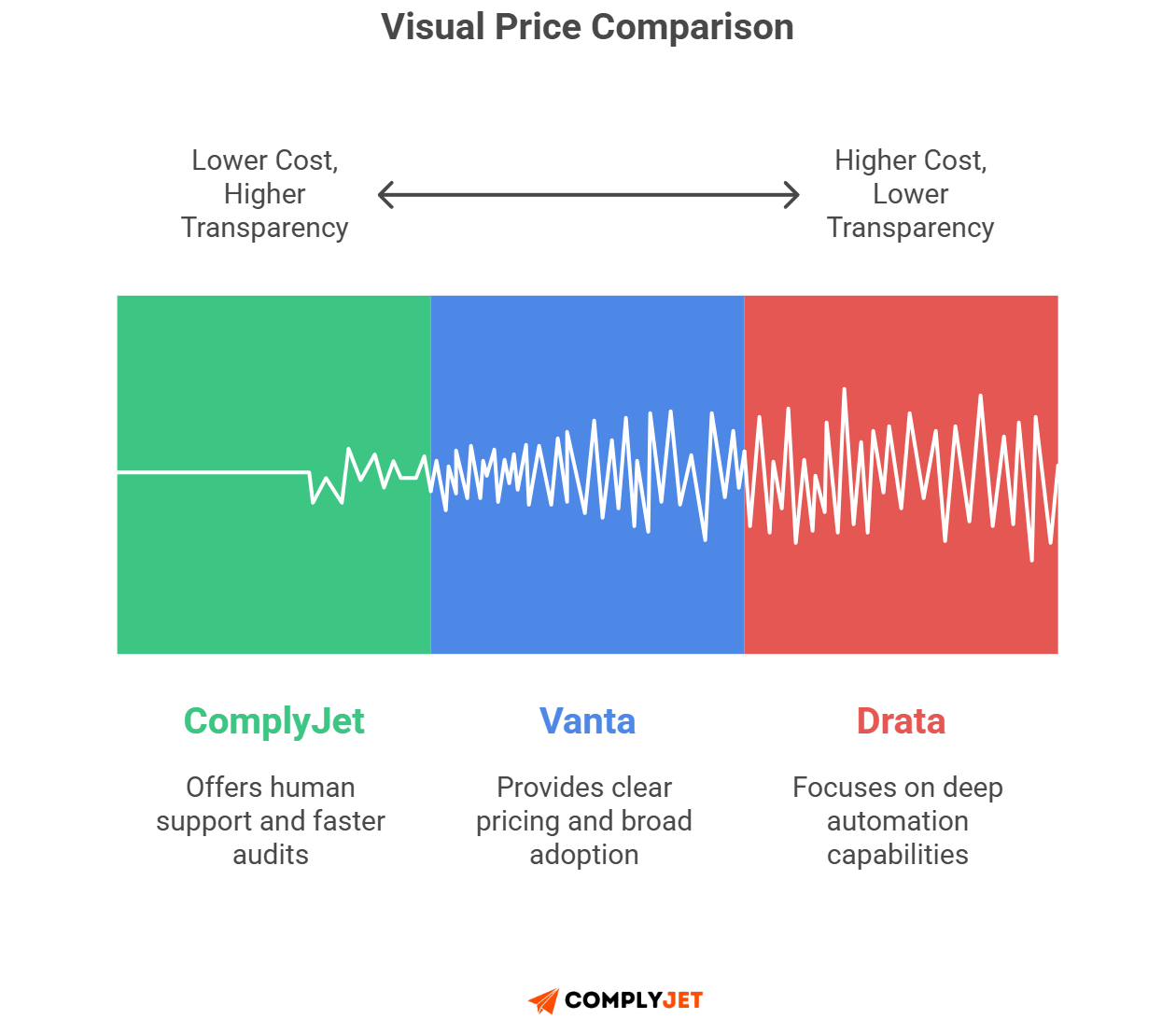
For more clarity, try ComplyJet's FREE TRIAL!



